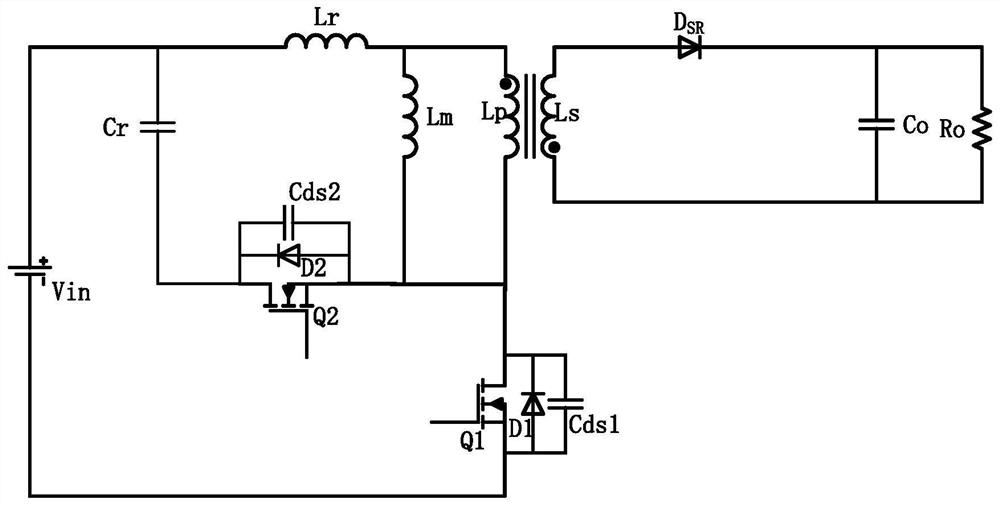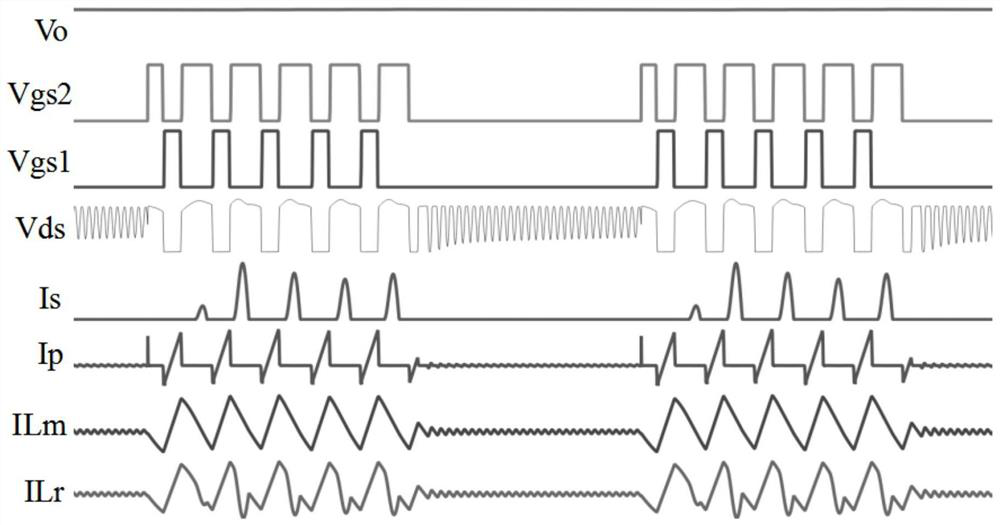A control method for a flyback converter
A flyback converter and control method technology, applied in control/regulation systems, conversion of DC power input to DC power output, instruments, etc., can solve the problems of large oscillation and main switch current spikes, etc., to reduce oscillation and alleviate The effect of filtering pressure and improving efficiency
- Summary
- Abstract
- Description
- Claims
- Application Information
AI Technical Summary
Problems solved by technology
Method used
Image
Examples
Embodiment 1
[0056] Such as Figure 4 to Figure 6 As shown, the present invention discloses a control method of a flyback converter, which is suitable for a flyback converter composed of a main power circuit, a clamp circuit and an output filter circuit; the main power circuit is provided with a transformer and a main switch Tube Q1, the clamping circuit is provided with a clamping capacitor Cr and a main clamping tube Q4, the first end of the primary winding Lp of the transformer is used as the positive input terminal VIN+ of the flyback converter, and the primary side The second end of the winding Lp, the drain of the main switching transistor Q1, and the source of the main clamping transistor Q4 are connected, and the drain of the main clamping transistor Q4 is connected to the The positive input terminal VIN+, the source of the main switching tube Q1 is used as the negative input terminal VIN- of the flyback converter; the secondary winding Ls of the transformer is used to output direc...
Embodiment approach
[0108]The level state of the main clamp driving signal Vgs4 in the first period is: it changes in a straight-line rising manner, gradually rising from low level to high level, that is: the main clamp driving signal Vgs4 is at The first period is a triangle wave.
[0109] In addition, the level state of the main clamp driving signal Vgs4 in the first period, in addition to changing in a straight line, can also follow other curves such as arc rise, as long as it can be gradually increased from low level to High level is enough.
Embodiment 3
[0111] On the basis of the above-mentioned embodiment 1 or embodiment 2, this embodiment 3 also adopts the following preferred implementation modes:
[0112] The ΔT1, ΔT3, ΔT5, ΔT6, and ΔT8 all take the minimum value, that is:
[0113] At the end of the first period, that is, at time t1, the excitation inductance Lm and leakage inductance Lr of the transformer are stored to the minimum energy required to realize the zero-voltage switching of the main switching tube Q1;
[0114] At the end of the third period, that is, at time t3, the voltage of the parasitic capacitance Cds1 of the main switching transistor Q1 drops to zero;
[0115] At the end of the fifth period, that is, at time t5, the drain-source voltage of the main switching transistor Q1 rises to Vin+Vc;
[0116] At the end of the sixth period, that is, at time t6, the secondary current of the transformer is reduced to zero;
[0117] At the end of the eighth period, that is, at time t8, the voltage of the parasitic c...
PUM
 Login to View More
Login to View More Abstract
Description
Claims
Application Information
 Login to View More
Login to View More - R&D
- Intellectual Property
- Life Sciences
- Materials
- Tech Scout
- Unparalleled Data Quality
- Higher Quality Content
- 60% Fewer Hallucinations
Browse by: Latest US Patents, China's latest patents, Technical Efficacy Thesaurus, Application Domain, Technology Topic, Popular Technical Reports.
© 2025 PatSnap. All rights reserved.Legal|Privacy policy|Modern Slavery Act Transparency Statement|Sitemap|About US| Contact US: help@patsnap.com



